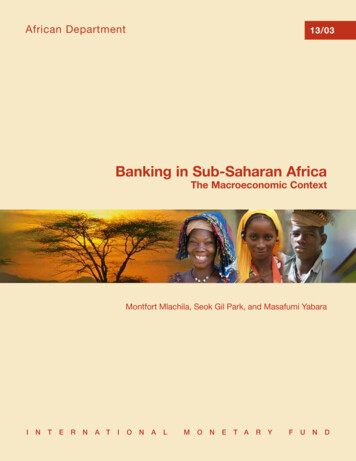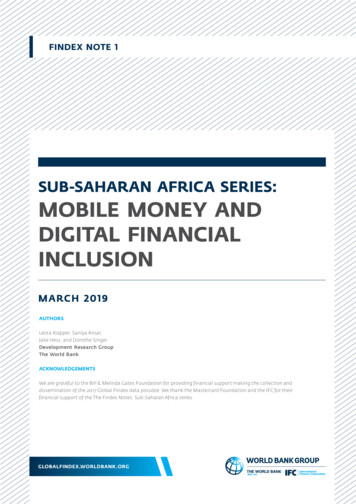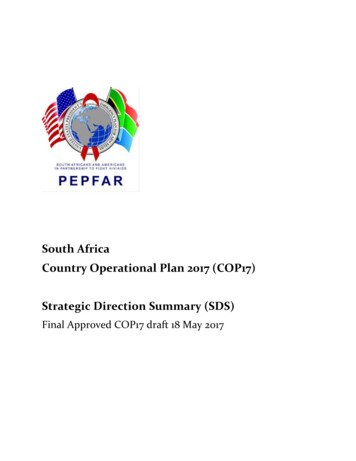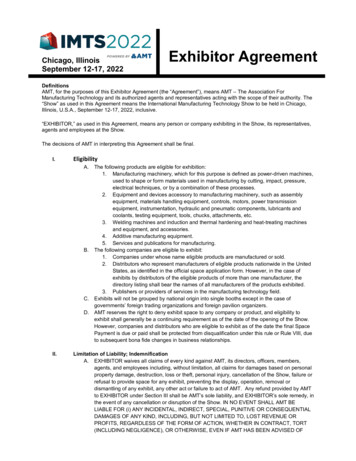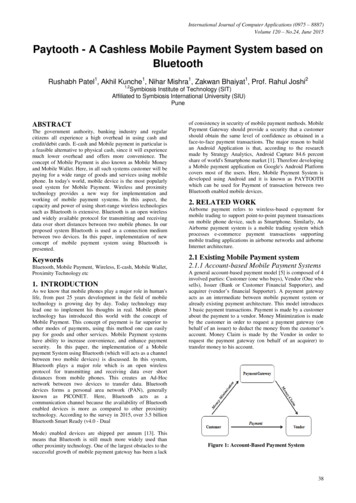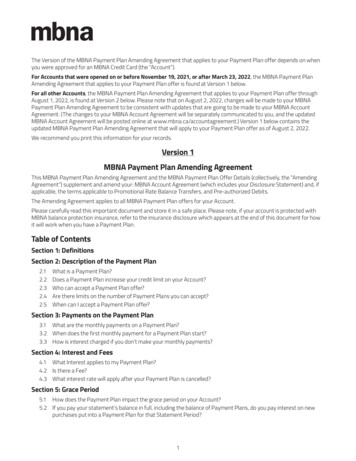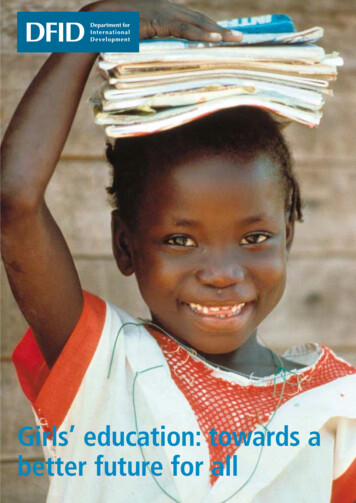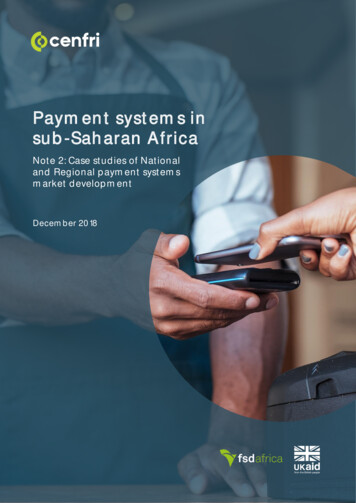
Transcription
Payment systems insub-Saharan AfricaNote 2: Case studies of Nationaland Regional payment systemsmarket developmentDecember 2018
AuthorsBarry CooperChristine HougaardLaura Munoz PerezChristiaan LootsRose Tuyeni PeterMatthew FerreiraMatthew DunnCentre for Financial Regulation & InclusionTel. 27 21 913 9510Email: info@cenfri.orgThe Vineyards Office EstateFarm 1, Block A99 Jip de Jager DriveBellville, 7530South AfricaPO Box 5966Tygervalley, 7535South Africawww.cenfri.orgPayment systems in sub-Saharan African: Note 2 December 20181
Table of contentsIntroduction5Regional payment system case studies6National payment system case studies26Conclusion60References61Appendix67List of figuresFigure 1: Value and volume of transactions processed through SADC RTGS from July 2013 toFebruary 2018Figure 2: EAPS money transfer processFigure 3: Volume and value of mobile financial servicesFigure 4: Distribution of payment instruments in terms of volume and value (2016)Figure 5: Number of ATMs per 100,000 adultsFigure 6: Volume and value of mobile-money payments in CEMACFigure 7: Prepaid card transactionsFigure 8: Value of NEFT and NIP transactions from January 2016 to February 2018 (in millions)Figure 9: Volume of NEFT and NIP transactions from January 2016 to February 2018 (in millions)Figure 10: Value and volume of mobile-money transactions from January 2016 to February 2018Figure 11. Primary constraints along the property market value chainFigure 12: Madagascar National Payment SystemFigure 13: Average size of transaction for Cheque, EFT and mobile payments in Madagascar (2017)Figure 14: Growth in active mobile-money accounts between 2010 and 2016Figure 15: Tanzania National Payment systemFigure 16: Value of transactions using different payment channels (2011 2015)Figure 17: Value of transactions for mobile and internet (2011 2015)Figure 18: Average size of transaction for various payments channelsFigure 19: Growth of ATM and POS devices per 100k adults (2011-2015)Figure 20: Financial access points per 100,000 adultsFigure 21: Mobile financial services in CôFigure 22: Retail transactions processed through 4555657List of boxesBox 1: An illustration of the non-competitive or cooperative space vs the competitive space of apayment system7Payment systems in sub-Saharan African: Note 2 December 20182
List of tablesTable 1: Payment trends across five EAC countries (2016) . 13Table 2: Three tiers of KYC requirements in Nigeria. 31Table 3: Bank participation in domestic payment system versus SADC RTGS . 67Table 4: List of stakeholder engagements . 68Abbreviations and acronymsACHautomated clearing houseAML/CFTanti-money laundering and the combating of financing of terrorismAPIapplication programming interfaceARTCIBCEAOCentral Bank of West African StatesBEACCentral Bank of Central African StatesBONBank of NamibiaBOTBank of TanzaniaBVNbank verification numberCBNCentral Bank of NigeriaCCBGCommittee of Central Bank GovernorsCDICEMACEconomic and Monetary Community of Central AfricaCIFTCBN Inter-Bank Fund TransferCMACommon Monetary AreaCOBACBanking Commission of Central AfricaCOMESACommon Market for Eastern and Southern AfricaDFSdigital financial servicesEACEast Africa CommunityEAPSEast Africa Payment SystemEFTelectronic fund transferEMIelectronic money issuerFDIforeign direct investmentFIPfinance and investment protocolFSPfinancial service providerGDPgross domestic productGhIPSSGhana Interbank Payment and Settlement SystemsGIMACGroupement Interbancaire Monétique de l'Afrique Centrale(Interbank Payment Systems Group of Central Africa)GIM-UEMOAWAEMU Interbank Electronic Banking GroupICTinformation and communications technologyKYCknow your customerPayment systems in sub-Saharan African: Note 2 December 20183
MFImicrofinance institutionMMOmobile money operatorMNOmobile network operatorMOUmemorandum of understandingMTOmoney transfer operatorNACSNigerian Automated Clearing SystemNCCNigerian Communications CommissionNCSNigerian Central SwitchNDICNigerian Deposit Insurance CorporationNEFTNIBSS Electronic Funds TransferNFCnear-field communicationNIBSSNigerian Inter-Bank Settlement SystemNIPNIBSS Instant PaymentNPSnational payment ment clearing housePFMIPrincipals of Financial Market InfrastructurePOSpoint of servicePSMpayment systems managementPSOpayment system operatorPSPpayment service providerRCHregional clearing houseREPSSregional payments and settlements systemRFIregional financial integrationRTGSreal-time gross settlementSADCSouthern African Development CommunitySADCBASADC Banking AssociationSARBSouth African Reserve BankSICA-UEMOASystem for clearing low-value interbank ACH payments in WAEMUSIPSsystemically important payment systemsSIRESSSADC Integrated Regional Electronic Settlement SystemSMICEMAC Interbank Card Payment SystemSSAsub-Saharan AfricaSTAR-UEMOARTGS system in WAEMUSTPStraight through processingSYGMAreal-time gross settlement system of CEMAC regionSYSTACautomated clearing system of CEMAC regionTACHTanzania Automated Clearing houseTISSTanzania Interbank Settlement SystemUSSDUnstructured Supplementary Service DataWAEMUWest African Economic and Monetary UnionPayment systems in sub-Saharan African: Note 2 December 20184
1IntroductionThis note explores the state of national andregional payment systems development in subSaharan Africa (SSA). This is achieved through theconsideration of four case studies of regional1payment systems as well as five case studies ofnational2 payment systems in SSA. These casestudies have been chosen as they displayparticularities from which we can drawconclusions applicable to other countries. Theregional payment systems under considerationrange from cross-border bilateral bankingrelationships between member countries to fullycentralised regional systems. At a country level,we consider a diverse array of national paymentsystems shaped by nuances such as high mobilephone penetration, innovative biometricsolutions and low population density. Trends: Emerging trends related to paymentsystem use and innovations in the nationaland regional contexts Key learnings: Each case study concludeswith a brief synthesis of key learnings andinsights that have emerged within thepayment system of the specific region orcountry.This note should be read in conjunction withNote 1, which distils the issues identified acrossthe case studies into a set of imperatives forpayment system development in SSA.For each case study, we broadly consider thefollowing: Payment system infrastructure: A criticalelement of any payment system is theinfrastructure that supports the clearingand/or settlement of payments. Each casestudy considers the various hardware,software, secure telecommunications networkand operating environments used to manageand operate payment systems at national andregional levels. Regulation: This section considers theprevailing regulatory environment and theways in which payment system regulation hasevolved in the face of recent political andtechnological developments.1Southern African Development Community (SADC), East African Community (EAC), West African Economic and MonetaryUnion (WAEMU) and Economic and Monetary Community of Central Africa (CEMAC)2d TanzaniaPayment systems in sub-Saharan African: Note 2 December 20185
2Regional paymentsystem case studiesA regional payment system is an internationalmechanism designed to facilitate paymentsbetween residents of the participating countries.The process of regional integration involves theimplementation of common rules, standards orinfrastructures among a diverse group ofstakeholders. An intended outcome of this systemis increased efficiency, affordability and security ofintra-regional fund transfers. As SSA begins tointegrate economically and promote open tradeamong member states, maintaining fragmentednational payment systems may become ahindrance to larger goals of economicdevelopment and cooperation. As suregional payment systems play an important rolein driving national and regional economic growth.The development of national payment system(NPS) considered a prerequisite to regionalintegration. In 1996, with help from the IMF,2.1.SADC payment systems integration part ofbroader regional integration mandate. ToSADC: Regional paymentsystems integration in fullswingStrong regional integration mandate. SADC is aninter-governmental organisation with the goal topromote sustainable and equitable economicgrowth and socio-economic development throughefficient productive systems, deeper cooperationand integration, good governance and durablepeace and security among its members (SADC,2012). It was formed in August 1992 and is made upof 15 member states. SADC has a total populationof 333 million people and a combined GDP ofUSD584 billion (World Bank, 2018a).World Bank and BIS, SADC launched an initiativeto implement an NPS in each SADC country.The aim was to help SADC countries to definetheir domestic strategies and development plans.The World Bank provided a financial grant in 1996and another in 2006 to support these initiatives,while the IMF and BIS provided advice andtechnical assistance. SADC considered it importantthat each member country had a robust domesticpayment system as a prerequisite to developinga cross-border and regional payment system(Wentworth, 2013).achieve the above-mentioned goals and capitaliseon regional development opportunities, amultiphase, regional payment system project wasinitiated by SADC financial industry stakeholders3.The aim of the SADC payment systems project4 isto achieve regional financial integration (RFI).Aligned with this outcome, the SADC Finance andInvestment Protocol (FIP) was signed in August2006 by 14 SADC members5 and came into effectin 2010.Its two main objectives were to improve theinvestment climate in each member state andimprove foreign and intra-regional investmentflows by enhancing cooperation, coordinationand harmonisation in financial sectors at anational and regional level.3These included the private sector essentially commercial banks that are members of the SADC Banking Association(SADCBA) and the central banks in the SADC member states (Wentworth, 2013).4The SADC Committee of Central Bank Governors (CCBG) approved the SADC Payment Integrations System project in May2009.5Excluding the SeychellesPayment systems in sub-Saharan African: Note 2 December 20186
Ostensibly, these measures were implemented torealise the numerous benefits of RFI. This includesthe creation of incentives for domestic paymentsystems reform, increasing economies of scale inoperations and competition, promoting FDI andallowing local financial service institutions to growregionally, continentally and globally (Wentworth,2013).Payments infrastructureShared regional payment systems increasingregional trade and fostering coordination andharmonisation in NPSs. At the core of the SADCPayment Integrations System project are theprinciples of interoperability and a cooperativespace. Interoperability brings all member countriesand their banks together to share the sameplatform to facilitate cross-border payments.Box 1 illustrates this idea:Box 1: An illustration of the non-competitive or cooperative space vs thecompetitive space of a payment systemThe figure below illustrates the cooperative vs the competitive space of a payment system. A cooperative spacereinforces shared aspects of the platform by focusing efforts on the development of the industry. This typicallyincorporates essential rules, protocols, networks and infrastructure, such as USSD networks, which all paymentactors can leverage within the payment ecosystem. The competitive space includes the infrastructure andservices that payment systems participants provide to their customers. (McQuerry & Northup, 2017).Source: Adapted from McQuerry & Northup, 2017 and SADC Banking Association, 2017Payment systems in sub-Saharan African: Note 2 December 20187
SADC RTGS 6 facilitating real-time, large-valueinterbank settlements between SADC banks andnon-banks. The regional payment project createdthe SADC Real Time Gross Settlement System(RTGS). SADC RTGS became operational in July2013 in four countries of the Common MonetaryArea (CMA)7. The implementation of SADC RTGSwas a partnership between private commercialbanks, as SADC Banking Association (SADCBA)members, and central banks of SADC memberstates. SADC RTGS allows banks within SADC tosettle payments between one another in real time.This means that banks can maintain theircorrespondent banking relationships but eliminateany inter-bank settlement risk in intra-SADC crossborder payments (Chilosi, et al., 2013). SADC RTGSis owned by SADC through the SADC CCBG. It ishosted and operated by the South African ReserveBank (SARB). Therefore, SADC RTGS is managedand regulated in terms of South African legislation.SADC RTGS currently settles in South African randbut will begin settling in USD in October 2018(SADC Banking Association, 2018). Banks and nonbanks that are authorised to participate in thesettlement systems of their home countries arepermitted to participate in SADC RTGS (SouthAfrican Reserve Bank, 2018).Payments trendsThe value provided by SADC RTGS is evidenced bysignificant growth in usage since inception. Figure 1on the next page, shows the volume and value oftransactions processed through SADC RTGS sinceits inception in 2013. In July 2013, approximately500 transactions (valued at USD813 million) wereprocessed; and in less than five years, this grew to26,845 transactions (valued at USD8.1 billion)processed in February 2018. By February 2018,SADC RTGS had processed almost 1 milliontransactions (worth USD343 billion, i.e. overZAR4 trillion) in total. When one considers thevalue saved in correspondent banking fees and thevolume of regional trade that SADC RTGS hasfacilitated in its short lifespan, it is clear that theregional RTGS has played an important role inpromoting regional financial integration andeconomic development.67The CMA consists of Lesotho, Namibia, South Africa and Swaziland (Wang, et al., 2007)Payment systems in sub-Saharan African: Note 2 December 20188
olume of transactionsValue of transactionsin USD (billions)120,0Volume of transactionsValue of transactions (USD)Figure 1: Value and volume of transactions processed through SADC RTGS from July 2013 to February 2018Source: (SADC, 2017) and (SIRESS, 2017)Regional clearing house (RCH) to clear retailpayments in the near future, but only for crossborder payments. There are plans for retail crossborder payments to be cleared using a regionalautomated clearing house (ACH) for low-valuepayments, such as card, EFT credit and debit, cardand ATM payments (Wentworth, 2013). Domesticpayments will still be cleared locally and settledusing local RTGS systems. In June 2015, the SADCACH Association (SACHA), an association of SADCclearing houses, authorised BankservAfrica to bethe operator of the regional clearing system. Theirlicence is renewable every two years. Given thatSADC countries are at different stages of paymentinfrastructure development, it was estimated thatat least four years from inception would be neededto achieve a high level of retail payment processingcapability both regionally and domestically; and2020 has been set as the target for achieving this.To achieve this target, SADC countries need tobecome comfortable with joint ownership of costlyinfrastructure, shared processing platformswherever possible, re-use of existing infrastructurewhere this is available, and adoption of widelyaccepted international standards. Governmentdepartments will need to take the lead inconverting paper-based processes into digital ones,which will assist considerably. There are alsoongoing discussions regarding a regional securitiessettlement system (Wentworth, 2013).Regional clearing house (RCH) presentingopportunities for leveraging scale. Theestablishment of a SADC RCH aims to reduce thetime and cost of cross-border retail payments.Contrasted with SADC banks that maintain costlybilateral relationships with each other to facilitatecross-border retail payments, these banks will beable to link into the RCH. Much like how localclearing houses determine net positions and sendfiles to the national RTGS system for settlement,the RCH will do this for cross-border transactionsfor all SADC banks and send net positions to SADCRTGS for settlement (see Section 2.2.1 for moredetail on SADC RTGS). This will make cross-borderpayments within SADC more efficient and costeffective.Payment systems in sub-Saharan African: Note 2 December 20189
Key learningsExisting intra-regional trade able to justifytransition to regional payment systems. Giventhat there was already a high level of tradebetween SADC countries, there was already anexisting use case for the regional RTGS system,which further encouraged its usage.Integrated regional infrastructure promotesintraregional regional trade. The success of theSADC RTGS has shown the potential for welldeveloped regional payments infrastructure forfacilitating intraregional trade. The developmentof the RCH has the potential to deepen thisintegration by making cross-border retailpayments more efficient and affordable.However, the developing domestic paymentsystem for clearing and settling local payments isimportant for the full utilisation of the RCH to berealised. There is high-level buy-in to push for evengreater harmonisation through the creation ofSADC-level payment regulation and efforts beingmade to adhere to Principles of Financial MarketInfrastructures (PFMI) from the onset.2.2 East Africa Community:Leveraging existing systems tofacilitate cross border paymentsDespite good economic growth in recent years,EAC still struggling with poverty and inequality .The East Africa Community (EAC) is a regionalgovernmental organisation headquartered inArusha, Tanzania (EAC, 2017). Economic growth inEAC was 5.9% in 2017, and this trend is expected tocontinue in 2019 and 2020 (AFDB, 2018). AlthoughEast Africa has experienced relatively strongeconomic growth over the past decade, this8growth has generally not led to a reduction inpoverty and inequality.Limited intra-regional trade in the region . Majorcontributors to the GDP of EAC are the agriculturaland minerexports are coffee and tea, while they mostlyimport mineral fuels and related products (CGAP,2018). Although intra-regional trade has grownquite significantly between 2010 and 2015 (USD2.2billion to USD3.3 billion), it still forms a relativelysmall portion of total trade. In Tanzania and Kenya,intra-regional trade accounts for 7% and 7.7% oftotal trade respectively, while in Uganda andRwanda it is 19.2% and 24.12% respectively.However, CGAP (2018) notes that some of the intraregional trade can be attributed to exports ofcoffee and tea, as landlocked countries in theregion send goods to coastal countries for export.Payments infrastructureMost countries in EAC having core basicpayments infrastructure in place . In terms ofpayment systems, each of the EAC countries haswell-established systems with electronicprocessing of cheques, low-value EFTs and largevalue EFTs through an RTGS system. Thesepayments are facilitated by national clearinghouses, which operate similarly despite a fewdifferences. For example, the time taken to processtransactions, the cost of each system, and thetransaction sizes processed by each system differ.Both cheque and EFT processing are noted byCGAP (2018) as being relatively expensive. Eachcountry now processes cheques with truncationtechnology8.Rwanda was the last country in EAC to implement cheque truncation, an important technology for digitising cheque processing.This was done early in 2018.Payment systems in sub-Saharan African: Note 2 December 201810
Countries in EAC lacking card switches thatoperate at significant scale nationally, despitegenerally well-developed payment systems .Most of the big banks in EAC issue Mastercard/Visacards, while smaller banks issue cards supportedby domestic aggregators, such as Umoja inTanzania, and Kenswitch in Kenya. Since largebanks are not part of the local card switches,they tend to process insufficient payment volumesto achieve significant scale (CGAP, 2018). Thedevelopment of card payment systems in EAChas therefore been slow and lags behind otherdevelopments. Tanzania is now considering anational switch to promote interoperability anddevelopment of card technology in the country(Mirondo & Malanga, 2017).EAPS leveraging current infrastructure to createan intra-regional system . Rather than establishingentirely new infrastructure and a centralisedclearing house, EAPS leverages on existing RTGSsystems of all participating countries to create across-border platform. In other words, it establishesa bilateral account between each RTGS system inthe region. It is a multi-currency system in whichtransactions are settled in local currencies, not inUSD (Sebabi, 2010). EAPS was established for thepurpose of facilitating intra-regional trade in theEAC region specifically. It therefore includes all EACcountries, with Burundi being the most recent tobe connected (CGAP, 2018). A typical paymentthrough EAPS is illustrated in Figure 2 below.There are two major regional payment systems thatcan be used for cross-border transactions: Regional Payments and Settlements System(REPSS)East Africa Payment System (EAPS)Usage of REPSS limited by high expense andlong processing times. REPSS enables crossborder payments by establishing a central clearinghouse that each participating central bank holdsan account with. In the case of REPSS, the centralclearing house is the Central Bank of Mauritius. Anypayments made between participating countriesare cleared daily, on a net basis, by the CentralBank of Mauritius. Settlement is done in USD/EUR.Cooper et al. (2017) note that banks do not oftenopt to use REPSS due it being expensive andtaking relatively long to process transactions. It isused infrequently and for large-scale RTGS systemtransactions across borders. REPSS was notactually established for EAC per se but wasestablished for the COMESA region. As such, itincludes only some EAC countries.Figure 2: EAPS money transfer processSource: (Sebabi, 2010)Payment systems in sub-Saharan African: Note 2 December 201811
EAPS is an innovative method for facilitating crossborder trinfrastructure since it utilises the existing RTGSsystem infrastructure of countries in the region.This means it can be implemented cheaply andbuilds on payments networks that are already safeand effective.Inefficient for banks to hold multiple currencies.One of the drawbacks of EAPS is that it requirescommercial banks to maintain pre-fundedsettlement accounts in the currencies of thepartner states at their central banks. Based ondiscussions with stakeholders, this has beenidentified as a problem for the system, especiallywhere banks have to hold currencies that are rarelytraded. This is because it is costly and inefficient tohold on to currencies that are not utilised or thatare rarely utilised.Lack of harmonisation of standards andregulation in the various jurisdictions achallenge. Differences in regulation of paymentsystems in each country have led to confusionregarding key processes and operational principles.For example, the Consumer Due Diligence (CDD)requirements across countries in EAC are different.This presents a challenge for banks, which have tocomply with multiple different AML regimes.Moreover, operating standards in the variouspayment systems differ. For example, the timerequirements for processing payments aredifferent in each of the countries. These issuespresent challenges when EAPS is used for crossborder payments.Cross-border transactions in the EAC regionhappening mostly via bilateral relationshipsbetween banks. Stakeholder discussionsrevealed that most banks with a regional footprintacross EAC had already established regionalhubs and nostro-vostro accounts at the time ofimplementation of EAPS. Moreover, the EAC regionwas the only region in Africa that saw an increasein the number of foreign correspondent bankingrelationships since 2013 (SWIFT, 2018). Theseexisting relationships and new developments arein competition with EAPS and REPSS. As such,most cross-border payments happen via bilateralbanking arrangements, not via the regionalpayment systems (CGAP, 2018). According to thelatest SWIFT White paper (2018), in 2017 70% ofcross-border payments in EAC were conductedusing the US dollar as a settlement currency. Thissuggests relatively low usage of EAPS, which useslocal currencies.The EAPS system relatively underutilised: notnecessarily a bad thing. Given the above, theEAPS system is relatively underutilised. However,since EAPS uses already-established infrastructure,it was relatively cheap to implement. As such, it isnot necessarily problematic that current usage isunderwhelming, and the system might be wellplaced to absorb future demand.Payment systems in sub-Saharan African: Note 2 December 201812
Payment trendsTable 1 presents the volumes and values oftransactions for the five countries in EAC in 2016.Namely Burundi, Kenya, Tanzania, Rwanda andUganda.ChequeCardMobile moneyEFT233183,90326Total value (USD millions)31,79619,78766,60812,850Average value per transaction (USD)1,3996217496Total volume of transactions (USD millions)Table 1: Payment trends across five EAC countries (2016)Source: (CGAP, 2017)Retail and wholesale markets served by differentchannels . From Table 3 it is clear that cheque andEFT are generally used infrequently and for largerpayments, such as trades and salaries. This isevidenced by relatively high-average value oftransactions (USD1,399 and USD496 respectively).Card and mobile appear to be used more for retailpayments, with much high annual volumes andlower average value per transaction.Mobile a systemically important paymentschannel in EAC. What is interesting to note is theextensive uptake and usage of mobile money inthe region. The total value of payments in thischannel in 2016 was USD66 billion, i.e. more thandouble the value of the next highest value channel(card transactions), which was USD23 billion. Thisconfirms that usage of mobile money across EAC ishigh enough to be considered systemicallyimportant for the region.Supporting channel infrastructure developedalongside mobile money to facilitate itsdevelopment. GSMA (2009) notes that animportant factor in the success of mobile moneyis the ability to reach scale quickly. One of theways to do this is to ensure that supportinginfrastructure is widely available, or at leastdeveloped soon after mobile money is launched.In Kenya and Tanzania (two countries in the EACregion where mobile money boomed), thedevelopment of agent infrastructure wasprioritised early on, and this allowed for theachievement of scale relatively quickly. In additionto simply increasing the physical supply of mobilemoney agents, it is important to consider otherinnovative ways to quickly provide supportingagent infrastructure. For example, Safaricom wasable to quickly offer M-PESA services throughoutKenya by expanding the current service offeringof its airtime agent outlets. This was especially easybecause they did not hold relationships orcontracts with individual agents, but withaggregator companies that themselves controlledand employed the actual network of agents.Thus, by signing agreements with a few aggregatorcompanies, Safaricom immediately extendedmobile money access through thousands of agentoutlets (GSMA, 2018).Payment systems in sub-Saharan African: Note 2 December 201813
Flexible regulatory structures allowing mobilemoney to flourish . A large factor in determiningthe success of mobile money in developingcountries is the way in which the regulatoryenvironments are structured (Evans & Pirchio, 2015).Where mobile money developed, countriesadopted light regulatory restrictions. This includedrelatively light KYC requirements, limitedrequirements for the involvement of banks otherthan to hold funds, allowing MNOs to issuee-money and allowing MNOs to have agents.Where mobile money failed, regulation oftenrequired banks to take the lead in productdevelopment, and stricter KYC was required.Further development of mobile money incountries with infrastructure constraints .Mobile money tends to be more successful incountries, such as those in EAC, where otherfinancial infrastructure and general infrastructureare relatively underdeveloped. For example, inNigeria and South Africa, there is already anextensive network of ATM and POS infrastructure.On the other hand, in many EAC countries (suchas Kenya), this infrastructure is lacking. However,mobile-phone penetration in these countries isrelatively high. As of 2017, 63% of Tanzanians owna mobile phone and 93% have access to one.Given high penetration of cellular phones incomparison to other infrastructure, mobile isparticularly well placed in some countries todevelop as a systemically important channel. Thisposes important questions regarding the channelsto develop depending on current infrastructuralconstraints and opportunities.and pre-existing bilateral relationships, the systemis well positioned to supply future demand.Regulatory harmonisation important for regionalpayment systems. It can be a challenge to makeuse of regional payment systems if the regulationin each pa
Payment systems in sub-Saharan African: Note 2 December 2018 2 Table of contents Introduction 5 Regional payment system case studies 6 National payment system case studies 26 Conclusion 60 References 61 Appendix 67 List of figures Figure 1: Value and volume of transactions processed through SADC RTGS from July 2013 to February 2018 9
